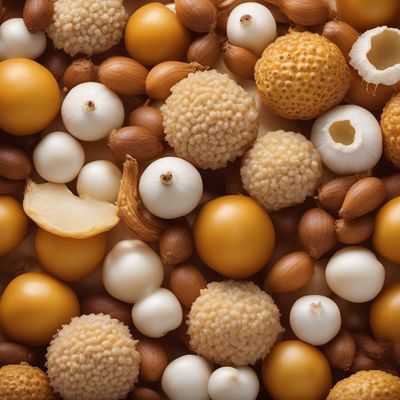
Ingredient
Mangosteens
The Exotic Jewel of Tropical Fruits
Mangosteens are small, round fruits with a thick, purple rind and soft, juicy flesh. The flesh is divided into several segments, which are sweet, tangy, and slightly acidic. The flavor profile of mangosteens is often described as a combination of peach, citrus, and strawberry. The fruit is typically eaten fresh, and its refreshing taste makes it a popular choice for desserts, juices, and sorbets. Mangosteens are a good source of vitamin C, fiber, and antioxidants.
Origins and history
Mangosteens are native to Southeast Asia, particularly Indonesia, Malaysia, and Thailand. They have a long history in the region and are considered a prized fruit. Mangosteens were traditionally used for their medicinal properties and were believed to have various health benefits. Today, they are cultivated in several tropical countries and are enjoyed for their unique taste and culinary versatility.
Nutritional information
Mangosteens are a good source of vitamin C, which supports immune health, and fiber, which aids digestion. They also contain antioxidants, such as xanthones, which have been studied for their potential anti-inflammatory and anti-cancer properties. A 100-gram serving of mangosteens provides approximately 73 calories.
Allergens
None known
How to select
When selecting mangosteens, look for fruits that have a vibrant purple rind with no signs of browning or mold. The rind should feel firm but yield slightly to gentle pressure. Avoid fruits with soft spots or bruises. Additionally, choose fruits that feel heavy for their size, as this indicates juiciness. It is best to consume mangosteens when they are fully ripe for the best flavor and texture.
Storage recommendations
To maintain the freshness and quality of mangosteens, store them at room temperature away from direct sunlight. Avoid refrigerating mangosteens, as this can cause them to dry out and lose flavor. Consume them within a few days of purchase for the best taste and texture.
How to produce
Mangosteens are typically grown in tropical regions with high humidity and rainfall. While it is challenging to grow mangosteens in non-tropical climates, amateur gardeners in suitable regions can attempt to cultivate them in greenhouses or containers. However, commercial production of mangosteens requires specialized techniques and specific growing conditions.
Preparation tips
Mangosteens are typically consumed fresh as a refreshing snack or used in various desserts and beverages. They can be added to fruit salads, smoothies, sorbets, or used as a topping for ice cream. In Southeast Asian cuisines, mangosteens are often paired with coconut milk in traditional desserts such as mangosteen pudding or mangosteen with sticky rice. The juice of mangosteens can also be extracted and used to make refreshing beverages.
Culinary uses
Mangosteens are commonly used in Southeast Asian cuisines, particularly in Thailand, Indonesia, and Malaysia. They are often incorporated into traditional desserts, fruit salads, and beverages. Mangosteens are also exported to other countries and can be found in specialty grocery stores or Asian markets.
Availability
Southeast Asia, particularly Indonesia, Malaysia, and Thailand

